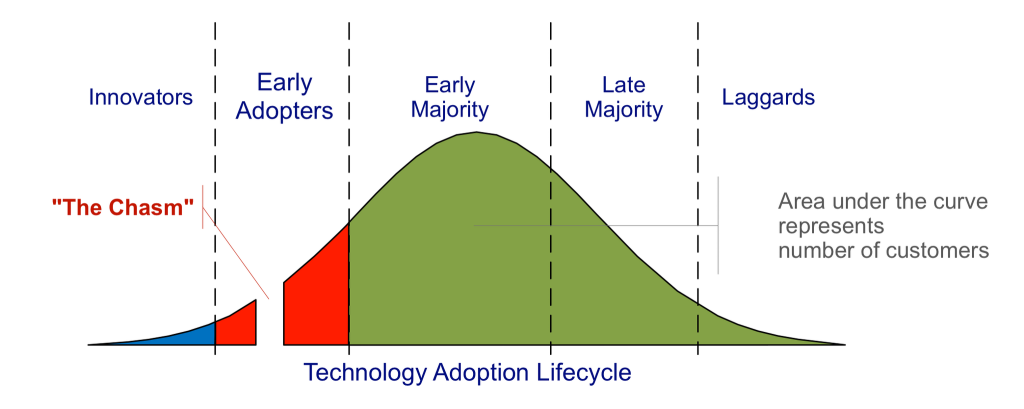So, you’ve wooed the tech geeks and early adopters with your shiny new gadget or innovative app. Great! But now you’re staring at the vast chasm between them and the early majority, wondering how to leap across without falling in. Innovators and early adopters are the initial groups in the technology adoption lifecycle, a concept introduced by Geoffrey Moore in “Crossing the Chasm.” These groups are essential for getting your product off the ground, but the early majority is where true scalability happens. Don’t worry, I’ve got your back. Let’s dive into some killer strategies inspired by the likes of Moore, Eric Ries, and W. Chan Kim & Renée Mauborgne.

Understand Your Market: Bridging the Gap with Early Adopters
Geoffrey Moore’s “Crossing the Chasm” is like the Bible for tech startups trying to move from the early adopters to the early majority. It’s all about understanding the lifecycle of technology adoption.
Identify and Nurture Early Adopters
Early adopters are like the cool kids who always have the latest tech before it’s mainstream. They love being in the know. So, how do you get these trendsetters on board? Engage them with targeted marketing, personalized shout-outs, and maybe a little swag. Once you’ve got them hooked, let them sing your praises.
Develop a Beachhead Market
Instead of trying to conquer the world all at once, start small. Focus on a niche market where you can dominate before expanding. This way, you refine your product and message, making it irresistible to the early majority. Think of it as your launching pad to greatness. Airbnb started by focusing on tech-savvy urban dwellers and event attendees, such as those attending the Democratic National Convention in 2008. This initial focus allowed them to refine their service and build a loyal user base before expanding globally.
Test and Learn: Adopt Lean Principles
Eric Ries’ “The Lean Startup” is all about the hustle. It’s like your scrappy guide to doing more with less. Ready to roll up your sleeves?
Implement the Build-Measure-Learn Loop
Start small and iterate quickly. Test different marketing messages, distribution channels, and pricing strategies like a mad scientist. Gather data, tweak, and repeat until you find what makes the early majority tick. Intuit’s development of QuickBooks used the build-measure-learn loop effectively by constantly refining their product based on real customer feedback, which led to a product that resonated deeply with small business owners.
Use MVPs to Gather Feedback
Unleash a Minimum Viable Product (MVP) to gather real-world feedback. It’s like putting out a rough cut of your movie to see what the audience thinks before the big premiere. Use this feedback to polish your product before going full throttle to the early majority. Buffer initially launched with a simple landing page to test the concept of a social media scheduling tool. This MVP allowed them to gather feedback and iterate quickly, leading to a robust product that appealed to a broader audience.
Create Uncontested Market Space: Innovate Your Channel Strategy
W. Chan Kim and Renée Mauborgne’s “Blue Ocean Strategy” is all about finding your unique groove. Why swim with the sharks when you can create your own blue ocean?
Value Innovation
Focus on what makes your customers tick and blow their minds with innovative value. If convenience is king, then build the slickest, fastest, most user-friendly platform out there. As Kim and Mauborgne say, offer value that competitors can’t match.
Use Strategic Pricing to Attract the More Price-Sensitive Early Majority
The early majority are not tech enthusiasts willing to pay any price. They’re more like, “Is this really worth it?” Consider penetration pricing strategies to hook them. It’s not about selling yourself short but about making your product accessible. For instance, Spotify used a freemium model to attract users, offering basic services for free while charging for premium features. This strategy allowed them to rapidly expand their user base and convert free users into paying customers.
Differentiate Your Offering
Stand out from the crowd. Offer something your competitors don’t. Superior customer support, killer educational resources, or even just a product that’s stupidly easy to use. Make them think, “Why didn’t anyone think of this before?” One notable example is Peloton, which differentiated itself by combining high-quality fitness equipment with engaging and interactive live and on-demand workout classes, creating a strong community and a unique value proposition.
Practical Steps to Bridge the Gap
So, you’ve got the theory down. Now, let’s get practical. Here’s how to take all this wisdom and turn it into action:
Leverage Testimonials and Case Studies
Your early adopters love you? Great! Use their stories to win over the early majority. Show real-world success stories that make potential customers think, “If it worked for them, it’ll work for me.” Dropbox used a referral program to leverage their early adopters’ networks, offering extra storage space for every referred user who signed up. This strategy significantly boosted their user base, helping them cross the chasm to the early majority.
Enhance Product Accessibility
Make your product so user-friendly that even your grandma could use it. Offer comprehensive onboarding and support to ease any fears. The early majority wants reliability and ease of use – give it to them on a silver platter. Zoom’s user-friendly interface and easy onboarding process have made it a go-to solution for video conferencing, especially during the COVID-19 pandemic. Their focus on accessibility and reliability helped them scale rapidly.
Optimize Multi-Channel Distribution
Don’t put all your eggs in one basket. Use both online and offline channels to reach your audience. Combine e-commerce with physical retail or unique pop-up events. The more places people see you, the more likely they’ll think, “This must be the real deal.” Warby Parker utilized a multi-channel strategy by combining an online presence with physical retail stores and pop-up shops, offering customers a seamless shopping experience across different channels.
Focus on Scalability
Can your operations handle a surge in demand? Make sure your supply chain and customer service are ready to scale. The last thing you want is to be unprepared when the early majority starts knocking on your door. Slack’s freemium model allowed them to scale rapidly. They focused on creating a seamless user experience and robust infrastructure to handle the influx of users as they transitioned from early adopters to the early majority.
Moving from innovators and early adopters to the early majority is a wild ride, but with insights from Geoffrey Moore, Eric Ries, and W. Chan Kim & Renée Mauborgne, you’re armed and ready. Understand your market, continuously test and refine your approach, and create unique value propositions. You’ve got this. Time to leap across that chasm and conquer the world.
By integrating these tried-and-true strategies, you’re not only positioning your startup for success but also ensuring that your approach is as cutting-edge as the products you create. Now, figure out how to implement these at your company or collaborate with someone like me to put it into practice.
About the Author
Angkan Mukherjee works in growth strategy for high growth companies and is a graduate of the ESADE business school in Barcelona. Outside work, he volunteers as a mentor at incubators like eWorks and loves getting involved in every aspect of building ventures. He gets excited to talk to others like him and you can find some time to talk to him here.
References
Image- Craig Chelius, CC BY 3.0 https://creativecommons.org/licenses/by/3.0, via Wikimedia Commons
- “Crossing the Chasm” by Geoffrey Moore https://www.amazon.com/Crossing-Chasm-3rd-Disruptive-Mainstream/dp/0062292986
- “The Lean Startup” by Eric Ries https://www.amazon.com/Lean-Startup-Entrepreneurs-Continuous-Innovation/dp/0307887898
- “Blue Ocean Strategy” by W. Chan Kim and Renée Mauborgne https://www.amazon.com/Blue-Ocean-Strategy-Uncontested-Competition/dp/1591396190
- “How Airbnb designs for trust”, TedTalk https://www.ted.com/talks/joe_gebbia_how_airbnb_designs_for_trust
- “The Airbnb Story: How Three Ordinary Guys Disrupted an Industry, Made Billions . . . and Created Plenty of Controversy” by Leigh Gallagher https://www.amazon.com/Airbnb-Story-Disrupted-Industry-Controversy/dp/0544952669
- “How Intuit Reinvents Itself”, Harvard Business Review https://hbr.org/2011/12/how-intuit-reinvents-itself
- “How Buffer Raised $500,000 Without Spending A Dime On Advertising”, Forbes https://www.forbes.com/sites/theyec/2014/02/10/how-buffer-raised-500000-without-spending-a-dime-on-advertising/?sh=6d126a7559e2
- “Spotify Business Model”, FourWeekMBA https://fourweekmba.com/spotify-business-model/
- “Digital Disruptors: Peloton”, Digitopia https://digitopia.co/blog/digital-disruptors-peloton/
- “How Dropbox grew 3900% in 15 months – A comprehensive growth study”, GrowthHackers https://growthhackers.com/growth-studies/dropbox
- “Zoom’s Explosive Growth in 2020: How Did They Do It?”, Medium https://medium.com/swlh/zooms-explosive-growth-in-2020-how-did-they-do-it-b733932f1518
- “Warby Parker: How a Start-Up Became an Industry Disruptor”, Harvard Business Review https://hbr.org/2020/01/warby-parker-how-a-start-up-became-an-industry-disruptor
- “The Slack Story: How did it get so big so fast?”, TechCrunch https://techcrunch.com/2016/05/02/slack-story
